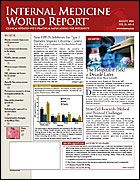Publication
Article
Internal Medicine World Report
Influenza in Preschoolers Widely Underdiagnosed
Author(s):
Affected Children Tax Inpatient, Outpatient Resources
Despite accounting for 50 clinic visits and 6 emergency department visits annually, influenza goes unrecognized in almost 3 of 4 young children.
N Engl J Med
These results, based on an analysis of data from the Centers for Disease Control and Prevention’s New Vaccine Surveillance Network (NVSN) (. 2006;355:31-40), are all the more alarming considering that influenza is a vaccine-preventable disease, and the associated extra burden on healthcare providers and the economy can at least in part be avoided.
From October 2000 through September 2004, 2797 children aged <5 years were hospitalized with acute respiratory tract infection or fever during the flu season. Parents of children aged 6 to 59 months (who were thus eligible for vaccination) reported that only 11% to 23% had received ≥1 influenza vaccine dose.
Laboratory testing conducted by the NVSN found that 160 of these hospitalized children had influenza, 49% of whom were younger than 6 months of age, and 80% were younger than 2 years.
Of the 1742 children aged ≥5 years seen in outpatient clinics and emergency departments for acute respiratory tract infection or fever during flu season, 274 had laboratory-confirmed influenza.
Parents of vaccine-eligible children seen in outpatient clinics reported that 30% had been vaccinated during the 2003-2004 season and 12% during the 2002-2003 season, while only 7% of children seen in emergency departments were vaccinated in either season.
While acknowledging the importance of hospitalizations due to influenza, Katherine A. Poehling, MD, MPH, of Vanderbilt University Medical Center, Nashville, Tenn, and colleagues write, “The average annual rates of outpatient visits attributable to influenza were approximately 10, 100, and 250 times as high as hospitalization rates for children 0 to 5 months, 6 to 23 months, and 24 to 59 months of age, respectively” (Table).
In addition, influenza diagnosis was missed in 72% of hospitalized children and 83% of children seen in outpatient settings who had laboratory-confirmed influenza, despite the availability and proven efficacy of rapid influenza tests.
In an accompanying editorial (pages 79-81), W. Paul Glezen, MD, of the Keck School of Medicine, University of Southern California, Los Angeles, points out that the influenza rates reported in the study “represent the minimum burden of influenza for preschool children,” since the NVSN data “did not include appreciable numbers of uninsured families.”
Dr Glezen refers to the high percentage of undiagnosed cases as a “missed opportunity to intervene to reduce both the risk of complications and the spread of the virus to contacts.”





